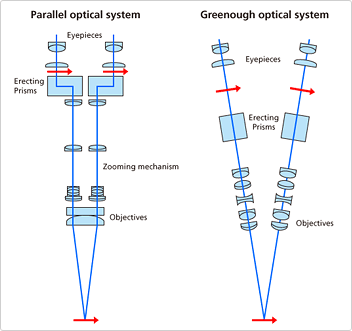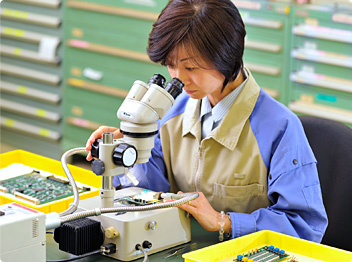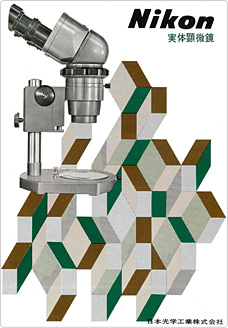
Stereoscopic Zoom Microscope (SMZ)
Magnification: 8x–40x (10x with eyepiece)
Objective lens: 0.8x–4x (5x zoom)
Working distance: 77.5 mm
Adjustable interpupillary distance: 56 mm–75 mm
Weight: Body, approximately 2.1 kg; stand, approximately 1.9 kg
Launched in 1961, the SMZ stereoscopic microscope continues to be manufactured and sold to this day.
With its reliability, durability, and the clarity of the observed images (in addition to its revolutionary zoom mechanism), the microscope is used in many industries, such as precision manufacturing and medical, as well as in biology and education. The following description of the SMZ—sales of which have spanned over half a century—includes comments by Atsushi Takeuchi, a Nikon microscope developer.
The product name "SMZ" is derived from the initials for "Stereo Microscope Zoom."
A stereoscopic microscope that enables stereoscopic viewing

Atsushi Takeuchi: Bioscience Development Division, Nikon Instruments Company. He has been in charge of microscope development for more than 20 years.
In human vision, the three-dimensional effect is created by a so-called "parallax"—the difference in the viewing angles of the physically separated left and right eyes. With a stereoscopic microscope, the observer uses both eyes. In other words, stereoscopic viewing is enabled by the parallax of the left and right eye, with each viewing the object through a different optical system. Since the stereoscopic microscope also incorporates an erecting prism, the user can observe an erect image without discomfort.
In light of these characteristics, stereoscopic microscopes are used for examining the unevenness and microscopic forms of an object under three-dimensional observation, as well as for precision assembly work.
The two types of optical system used in stereoscopic microscopes

The two types of optical systems used in stereoscopic microscopes are known as the parallel system, as shown on the right, and the Greenough system.
The parallel optical system runs parallel to the optical axes, making it comparatively simple to incorporate accessories, such as illumination and photographic equipment. Parallel optical systems are often used in stereoscopic microscopes employed in the fields of medicine and research.
By contrast, the Greenough optical system runs diagonally at an angle to the left and right optical axes. The simplicity of this optical system allows the construction of microscopes that are lower priced and more compact. The SMZ utilizes this Greenough optical system.
The zoom mechanism—one of only three in the world

Auto NIKKOR Telephoto-Zoom 8.5-25cm f/4-4.5, the first interchangeable zoom lens for the Nikon F Series, was launched in 1959. Technology from this zoom lens was utilized in the SMZ.
When the SMZ was released, a product catalog at the time stated that it "brought to reality the dream of converting stereoscopic microscopes to zoom—an oft-discussed topic in the world of optics," and described it as, "a revolutionary product geared to applications in the field of geometrical optics and featuring a zoom mechanism (as already implemented in camera lens) that has been specifically developed for application to the microscope."
The zoom mechanism for a microscope requires higher precision than that for a camera lens. There is also the constraint that the left and right optical systems must be equal, in terms of imaging capability, presenting development and production challenges. As a result, there were only three models of the microscope zoom mechanism at the start of the 1960s—one of which was Nikon's (formerly Nippon Kogaku K.K.). The SMZ could also boast a zoom ratio of 5x—the highest of the three.

Stereoscopic Microscope SM (released in 1954)
The forerunner of the SMZ, the SM, was released in 1954. With the SM, a handle was used to change the magnification by switching between three different objective lenses. However, this action would affect observation, as it caused a momentary blackout of the observed image when magnification was changed. This problem is eliminated by the SMZ's advanced zoom mechanism.
A tool fit for professionals

The zoom ring on the SMZ

Nikon also uses the SMZ in its own in-house inspection operations. Here, an electronic circuit board is being examined.
It was assumed during the development of the SMZ that the microscope would be used for observation or work lasting a considerable period of time. Hence, various measures were taken to increase working efficiency and to reduce the strain on the observer.
"The zoom mechanism on the SMZ minimized the detrimental effect on various observation factors, such as distortion of the observed image or slippage in the focal point caused by a change in the magnification. It was also said that, even after long hours of observation, the user's eyes did not get tired, since the images obtained for the left and right eyes were equally distinct."
"A visibility correction mechanism, which compensated for differences in visual acuity between the observer's left and right eyes, coupled with an interpupillary adjustment mechanism for matching the distance between the two eyepieces and between the observer's eyes, allowed each different user to obtain his or her optimal observation conditions."
"Operability was improved by inclining the eyepiece to a 45° angle, and by testing the positioning and rotation angle of the handle and ring. The inclined eyepiece allowed the observer to adopt a comfortable posture, while the ladder eased usability. To ensure high degrees of reliability and durability, rigorous testing was conducted on the assumption that the microscope would see long-term use in factories and similar environments. We were completely confident that this microscope could withstand the rigors of use by professionals," comments Mr. Takeuchi.
As soon as it was released, the SMZ became popular worldwide. During the 1980s, its success was such that Nikon supplied a single semiconductor factory with more than 1,000 models for exterior inspection of ICs.
The Good Design Long Life Design Award

The certificate and trophy for the Good Design Long Life Design Award
"Angular design—as typified by the Nikon F single-lens reflex camera—was the norm for Nikon products in the 1960s. Linear design was adopted at any cost in order to improve manufacturing efficiency. The release in 1971 of the Nikon F2 introduced more curves, producing a softer look. The Nikon designers who had designed the F2 turned their hands to the SMZ to create a microscope that was unconventional for the time, and this design still survives in the present-day SMZ Series," says Mr. Takeuchi.
In 2011, the SMZ received the Good Design Long Life Design Award, sponsored by the Japan Institute of Design Promotion. The product was cited as an outstanding design that enriches life, industry and society as a whole.
A product that harks back to Nikon's origins as a manufacturer

The cover of a catalog at the time of the launch of the SMZ, featuring an image with a 3D motif
Sales for the SMZ reflect continuing and unchanging demands for the product, especially in the manufacturing industry.
"Right from the start, the SMZ was a complete product, and there has been no need to alter its basic design and specifications. As a manufacturer, one's mission is to continue supplying the same product for generations, while at the same time responding to the enduring requirements of the marketplace. The quality of the SMZ and the trust that has been placed in the product—neither of which has wavered in 50 years—serve to remind us of our origins as a manufacturer," concludes Mr. Takeuchi.

